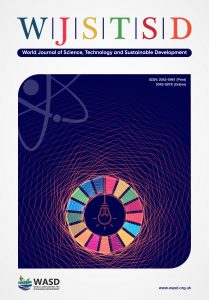Influencing sustainability by controlling future brownfields in Africa: a case study of Ethiopia, Dr. Mikiale Gebremariam, Prof. Yuming Zhu, Naveed Ahmad and Dr. Dawit Bekele
 Dr. Mikiale Gebreslase Gebremariam, Prof. Yuming Zhu, Naveed Ahmad
Dr. Mikiale Gebreslase Gebremariam, Prof. Yuming Zhu, Naveed Ahmad
Department of Management
Northwestern Polytechnical University, Xi’an
China
Email: garabandal1221@mail.nwpu.edu.cn
Dr. Dawit Nega Bekele
Global Center for Environmental Remediation
University of Newcastle, Callaghan
Australia
DOI: 10.1108/WJSTSD-04-2018-0031
Purpose: The increasing African population and economic growth leading to urbanisation continues to increase the need to redevelop brownfields as a strategy of encouraging sustainable development of cities, in particular in Ethiopia. However, the adoption of brownfield redevelopment in Ethiopia is at initial stage. Thus, the purpose of this paper is to highlight the framework based on grey-incidence decision-making approach to manage brownfields in African countries by taking Ethiopia as case example. The grey-incidence decision-making model integrates multiple factors such as economic, social, environmental, technical and associated risks and provides an effective decision-making and management tool for environmental practitioners and government agencies.
Design/methodology/approach: Questionnaires were used to collect data on terms and definitions of brownfield. The questions were prepared on the basis of currently used definitions developed by a number of developed countries. Moreover, this study utilises a grey-incidence decision-making approach to help in management and decision-making for the implementation of brownfield redevelopment projects (BRPs) in the remediated sites.
Findings: Standard definition of brownfield and essential guidelines for brownfield redevelopment is proposed for Ethiopian context. The research findings were tested and verified using literature data and survey from major stakeholders. In addition, the grey-incidence decision-making approach is applied for the evaluation of BRPs in the remediated sites. A framework is proposed to control future brownfields for African countries by taking Ethiopia as a case example.
Originality/value: This research stresses the significance of an urban structure to address sustainable development, and the need to consider redevelopment of brownfields and identify the potential for a specific government policy framework. This research provides the best opportunity for Ethiopia by devising an urban land policy and create a strategy to contribute social, economic, financial and environmental benefits. It also provides a foundation to solve environmental issues by involving all major stakeholders, including community citizens, environmentalists and government agencies, and it also serves as guidelines to transform brownfields into Greenfields; and finally, it contributes to achieve the 2030 UN global goals.
Keywords: Environment; Guidelines; Contamination; Brownfield; Grey-incidence decisions-making; Sustainable development goals (SDG’s).
Citation: Gebremariam, M.G., Zhu, Y., Ahmad, N. and Bekele, D.N. (2019), "Influencing sustainability by controlling future brownfields in Africa: a case study of Ethiopia", World Journal of Science, Technology and Sustainable Development, Vol. 16 No. 3, pp. 102-120. https://doi.org/10.1108/WJSTSD-04-2018-0031

